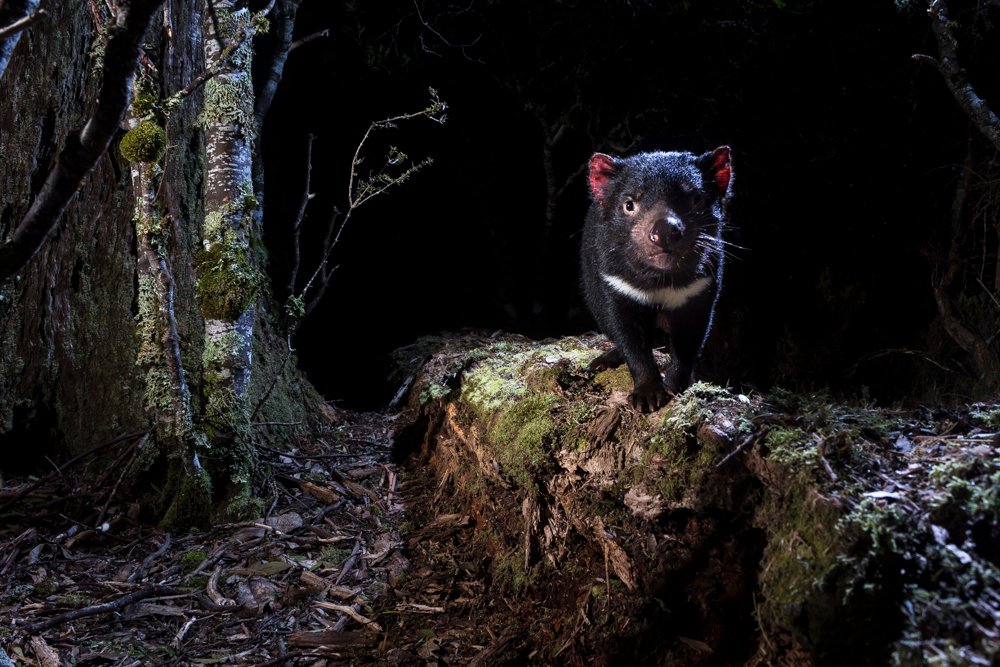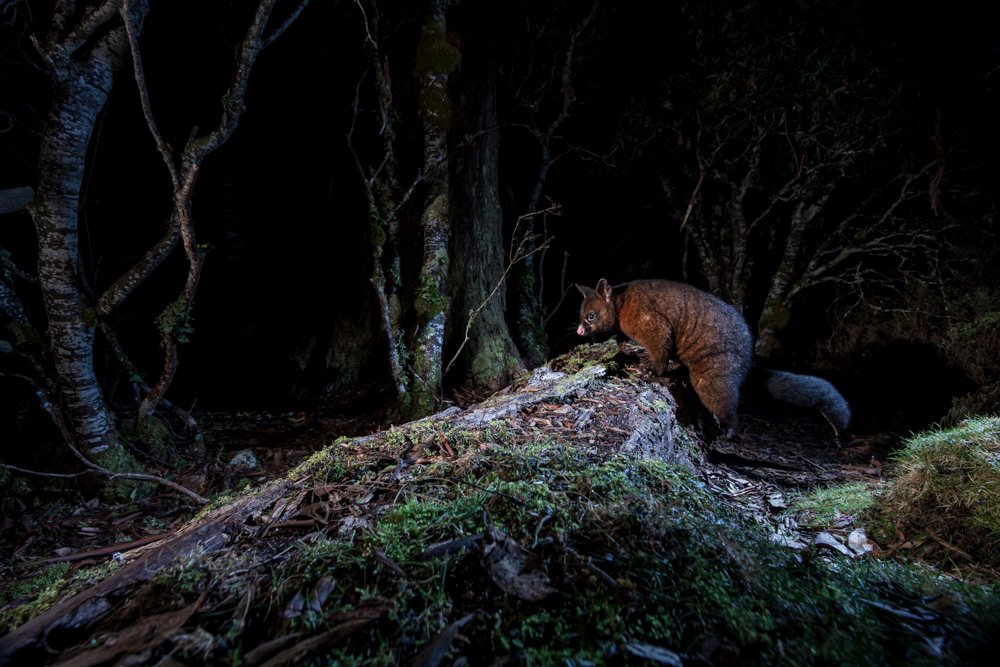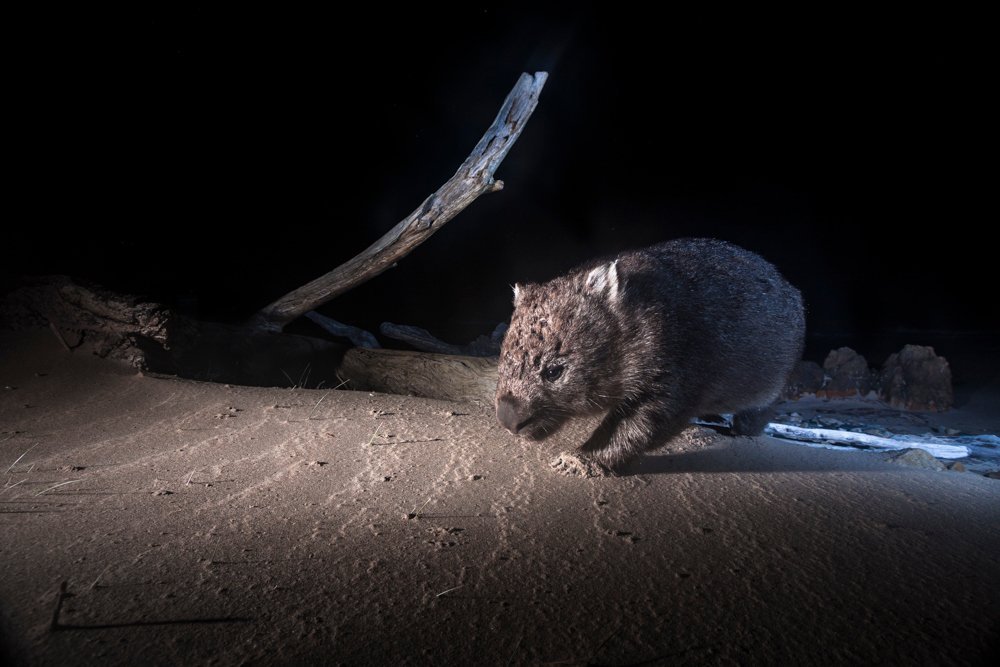Pro’s guide to wildlife photography in the field

WILDLIFE PHOTOGRAPHY IS an art for the patient and dedicated. If spending weeks, months or even years waiting for a few special shots doesn’t appeal to you, then maybe it’s not your thing.
I’m not exclusively a wildlife photographer but I have spent a good amount of time being bitten by bugs in Asian jungles, driving the North American west in search for grizzly bears and trekking endless miles through Tasmanian bush to check camera traps often in freezing winters. Like many, I have always had a fascination with the species and photography lining the pages of the best natural history magazines. To photograph them in a new way is tough, but not impossible – with some imagination and old fashioned hard work, you will soon find yourself on the right track.
My camera trapping work started when I returned to Tasmania after living and working in Asia for nearly two years. I gave myself an assignment, to photograph the Tasmanian devil in the wild. There were a few ethical boundaries I set for myself: no captive devils, no baiting and I would photograph them at night, they are nocturnal after all.

Behind the scenes, camera trapping for Tasmanian devils. (Image: Angi Kim)
The devil was a natural choice. It is iconic, mysterious and endangered. Additionally, after searching through image libraries it seemed no one was photographing the devil beyond wildlife parks or baited setups with horrible lighting. It has all the ingredients for an interesting personal project and photo essay.
After researching the species it was clear I needed to use camera traps to get the shots I was after. I studied the work of photographers who were also using camera traps on assignments to photograph elusive wildlife such as tigers, snow leopards, jaguars and many more. I began to understand the mechanics of how the camera traps worked and how I would go about taking on this project, and started shopping for a suitable infrared system, figuring out what I could source online and what I needed to design and build myself.
Devil’s in the detail

A devil unknowingly poses for a camera trap photo while scaling a log in the rainforest area of Cradle Mountain, Tasmania. (Image: Heath Holden)
The behavioural characteristics of Tasmanian devils presented some technical challenges. They are nocturnal which requires me to use flash – I am using multiple flashes and need to ensure they all wake and fire immediately when the camera is triggered. Getting that first shot is important and using a regular flash sync cable doesn’t send the required power signal the flashes need to wake fast enough, so how do I go about powering these flashes for extended periods?
Also, the devils I am attempting to photograph are wild and elusive, so where do I find them? Is my gear going to be safe set up in the bush for months at a time?
These are just some of the problems I had to work through. With trial and error, time and research I was able to solve them one by one. The camera traps I’ve built work well with minimal issues. Having worked with them for so long, I can usually diagnose and fix most small problems in the field.
Choosing a camera trap
Trail cameras
These are passive infra-red one piece units built into strong plastic waterproof cases. I use a Bushnell Trophy Cam. They have a sensor with a 40-degree angle of detection and when an animal wanders into that area, a video or still image is taken.
Image quality is ok, but they are most useful for monitoring a location for wildlife activity and determining whether it is worth setting up a DSLR trap. The camera I use runs on 12 AA batteries and can last up to 12 months depending on weather conditions and how often it is triggered. It shoots 1080p HD video and 8MP stills, the resolution and specs are now higher in the more current models.

Preparing the area and setting up a DSLR camera trap can take a couple of hours. You often have to create mounting points for the camera, IR system and the flashes. Then, once everything is mounted, comes the light placement and metering, avoiding shadows and doing your best to hide cables and keep any part of the gear out of the frame. (Image: Heath Holden)
During the day they record colour images and at night they switch to a black and white infrared image using a panel of IR illuminators to light the area. You can adjust basic settings such as trigger sensitivity, video recording time/number of images per trigger and delay between each trigger. These are an essential part of a camera trapping project.
DSLR camera traps
These are exactly what they sound like, a camera trap system using DSLR bodies and your own choice of lens.
For a complete working camera trap system you need many separate parts which all work together as one, they are listed below along with their purpose:
Camera body
Over the years I have used a range of Canon bodies, 1000D, 20D, 50D, 60D, 1Dmk3, 6D and an IR converted 5Dmk2.
I upgrade if I come across a second hand body at a good price. Canon bodies work well and seem to be durable enough to be left out in the weather when using a good housing, I haven’t had any personal experience with other brands but I know of photographers working with them successfully. They have good battery life when in auto-sleep mode, the infrared beam system will wake the camera instantly when triggered and you can get about a month using one standard battery.

A Tasmanian wombat (Vombatus ursinus tasmaniensis) approcaches a stream at Narawntapu National Park in Tasmania’s north-west. Shot by DSLR camera trap, no bait. (Image: Heath Holden)
I set the focus on the spot I want the wildlife to be photographed in, after a while I realised live-view was a very useful feature, at the time I was using a 20D (no live-view) and it was hard to get accurate focus using a wide angle lens while in awkward positions, often at ground level in forests and streams. The more recent cameras have a silent shutter mode which is also an advantage, each devil reacts differently to the camera trap going off but it makes sense that the least amount of noise you make the more natural the behaviour will be. You don’t need to go out and buy the latest 5Dmk8, the image quality of all DSLRs these days is really good; any second-hand body which is still in a reliable working condition will do the trick. My first feature story was in BBC Wildlife magazine and the double page opener was shot on a 10MP 1000D which I bought for next to nothing.
Lens
Typically if you’re working with camera traps you are targeting intimate shots of wildlife in their natural habitat, so wide angle is the most commonly used. When I’m using one of the smaller 1.6x sensor bodies I use a Canon 10-22mm f/3.5-4.5 USM zoom, usually set at 10 or 12mm, the kit 18-55mm f/3.5-5.6 EF-S lens or a 15mm f/2.8 fisheye. The distortion of the fisheye is easily fixed in Lightroom and the larger aperture is handy if I want to bring in some stars to the dark night sky. If I am using a full frame body I use a Canon 17-40 f/4L at 17mm.
Infra-red trigger system
The DSLR camera trap needs to be triggered by an IR unit. This is done by a passive or active infra-red sensor or beam. The passive system uses a sensor with an angle of detection (similar to the trail camera) and they monitor for infra-red radiation which is given off by animals – when detected, the camera will be triggered.

The first thing I look for when looking for a new location is scats, foot prints and piles of old bones. When I find a scene like this it is a sure thing I’m going to check it out a little further and put a trail cam there to see what activity is going on. (Image: Heath Holden)
This style of sensor is good if photographing a general area, if the wildlife is a bit unpredictable and isn’t on a clear path then this could be the option. The sensitivity is adjustable and the angle of detection can be varied by using shrouds on the sides of the unit. The active beam system consists of a transmitter and a receiver which pulses an IR beam between the two units, when this beam is broken it will trigger the camera. The active beam is more complex to setup but is more precise, you set the beam to cross exactly where you want the wildlife to be photographed in the frame. I have missed a couple of specific shots using the active beam – the devil didn’t quite break the beam and walked within an inch from crossing it, if I had been using a passive sensor I may have got the shot.
The active system is very programmable; you can fine-tune trigger sensitivity, trigger signal time, number of shots, time zones so you can program it to shoot only from sunset to sunrise or vice-versa. I use Trail Master infra-red gear but the other brands commonly used in the camera trapping world are CamTraptions and Sabre by Cognisys.
Footage of Tasmanian devils in the wild. (Video: Heath Holden)
Camera housing
There is not really an off-the-shelf option here, so some DIY, design and imagination is required.
I have built several different variations using different starting points including small rubbish bins, letterboxes, pelican cases and custom-made aluminium boxes. I have now come up with a consistent design that works well and fits different camera bodies. The pelican case seems to be the most common amongst other photographers working with camera traps around the world.
One point to remember when building a housing is to leave enough room above and beside the camera body for a hotshoe-mounted flash cable and a remote cable to be plugged in. I now have a couple of reliable housings which I confidently leave out no matter the conditions; they are totally weatherproof, unless the water rises from above… I had to save a camera when the stream I set up in rose suddenly and I returned to find the water level just touching the bottom of the camera (it lived to see another devil!). I have left cameras through full Tasmanian winters in well below-freezing temperatures with no problems other than a bit of lens fogging – this usually happens on sunrise and sunset when the temperature changes but it is not too much of a problem. One other problem is mud splashing up onto the lens port after heavy rain.
Flash

This shot of a possum is a good example of lighting style. There is a warm main light at camera left and a back light off to the camera right which you can see illuminates his tail and is a cooler temperature which creates depth and colour separation. (Image: Heath Holden)
In the beginning I was using my everyday Canon 580ex2 flash with an off-camera flash cable, it worked fine one day at a time, but the way it naturally operated didn’t allow the flash to sleep and wake properly so the batteries would barely last one full night. I would be camping out and trying to charge a bunch of AAs to reload it every night, it wasn’t really productive.
From my research I knew there were certain older Nikon flashes which held their charge well and would wake fast when triggered from sleep mode. I bought as many old Nikon SB28s as I could at a reasonable price, I have six now which gives me enough to run two or three camera setups, this flash can last a month or so on four AA batteries.
Using a Canon body with Nikon flashes has its problems, I had to build custom cables to switch the wire configuration from the corresponding Canon hotshoe to the Nikon flash terminals, I would then use Nikon’s old off-camera flash system with modified AS-10 adapters. In the field the flashes are mounted in a simple weatherproof plastic tube with a cap on the end and mounted with a small ball head to a tree.
Workflow and settings

This is a four-shot collage example of little things not quite working out. Out of focus, too close, wrong directions. The learning curve never stops, but it keeps you going. (Image: Heath Holden)
Before heading out to set up a camera trap I do a lot of planning. I first need to find a suitable spot with wildlife activity and obtain permission if it is a sensitive or private area.
I will session a location for at least six months making small changes depending on how productive it is. Sometimes I will have multiple cameras out in different areas. The locations are usually remote and can take an hour or more to reach and then a few kilometres of trekking; forgetting a cable, batteries or mounting gear can be a real inconvenience. Cable ties and tape have become a permanent fixture in my bag, you can mount anything with those items!
The setup
I compose the shot as I would if I were shooting normally and then build the lighting to suit the direction I hope the animal will pass through the camera trap. Sometimes I get an back-end shot but that’s not always bad. If it happens enough it means I need to turn the camera around. It is all a learning curve.

A wombat triggers a camera trap while walking along a west coast beach. (Image: Heath Holden)
Since I am targeting a nocturnal species and photographing in the dark, it is really the work of the flash to create the ‘feeling’ of the shot.
My work in editorial assignments and experience using flash has been a huge advantage in this work, I am really creating environmental portraits, just of devils not humans.
I zoom the flash heads and sometimes use a homemade snoot to control spill and shape the light. To avoid harsh lighting and horrible shadows I mount the lights as close as possible to the area in frame, this also helps by keeping the required power level low (meaning longer battery life).
Flashes are always set to manual power and I check the exposure with a light meter. Camera settings are usually f5.6 – f/8 and between ISO400 and ISO800. I use either manual or aperture-priority and vary the shutter speed from .5 sec to 1/100th in manual to control the fps speed of the camera in continuous mode, when in aperture-priority mode it will automatically crank out to 20 or 30 seconds, which usually only gives me one shot each trigger, but it has the possibility of letting some ambient moonlight bleed into the shot and eliminating a big black boring sky.

Tasmanian devil. (Image: Heath Holden)
Progress and outcome
What initially started out as a project to simply get some good natural shots of Tasmanian devils has now turned into a more extensive natural history story which I have loosely titled ‘The Life of a Tasmanian Devil’.
I’m trying to document as many aspects of the devil’s world as I can and there has never been a time when this species it needs it more.
This personal project fits well between other assignments; I have been documenting some of the Save the Tasmanian Devil Program research trapping trips and the lab work being done at the Menzies Institute for Medical Research to understand the devil facial tumour disease and try to create a vaccine to help the devils outlast this fatal disease.
I’m continuously photographing footprints, roadkill and landscapes which would be home to the devil. Wildlife parks also play an important role in this story; they have ongoing breeding programs and allow people to see this iconic species as it is very difficult to see them outside of a captive situation.

A large tumour can be see on this adult devil’s neck as it walks through an industrial area with crates and shipping containers. A family of devils was living in the area for around six months. Photographed by camera trap. (Image: Heath Holden)
I’m constantly writing down ideas for new shots and I will continue to work on this story and push it as far as I can.
You can follow Heath’s work on his website www.heathholdenphotography.com or on Instagram and Facebook.




